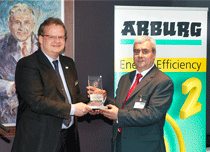Injection molding: Lego Group wins Arburg’s Energy Efficiency Award
Everyone knows the toys they make, but few realize the lengths Lego has gone to reduce its energy use. The company has increased its energy efficiency by 35% in the past three years, and is well on the way to slashing the energy used in injection molding by 45%. Challenged to help it realize these improvements has been injection molding machine manufacturer Arburg, which kicked off its annual Technology Days open house with the presentation of this year's Energy Efficiency Award.
March 23, 2011
Everyone knows the toys they make, but few realize the lengths Lego has gone to reduce its energy use. The company has increased its energy efficiency by 35% in the past three years, and is well on the way to slashing the energy used in injection molding by 45%. Challenged to help it realize these improvements has been injection molding machine manufacturer Arburg, which kicked off its annual Technology Days open house with the presentation of this year's Energy Efficiency Award.
|
Arburg managing partner Michael Hehl (left) presents the Energy Efficiency Award for 2011 to Lego's Bali Padda. |
Bali Padda, executive VP, global supply chain management at Lego, accepted the award for the toy maker. "A family-owned business can look at long term issues, and sustainability can become a central aspect of the company," he said, contrasting his employer with ones which he categorized as being too focused on hitting quarterly financial targets. That doesn't mean Lego is not in the business of making money; Padda insisted that sustainable plastics processing and manufacturing, in terms of energy use reduction and reduction of materials and waste, is the surest way of helping the bottom line.
"A lot of companies claim to be innovative, but Lego Group really pushes it to the limit," added Helmut Heinson, Arburg's managing director for sales, who helped present the award. Heinson and his colleagues openly admit that Lego is one of their more demanding customers but added that, in the long term, these are the type of processors from which the machine maker can most learn. The relationship between the two companies is indeed lengthy; Arburg's MD for technology, Herbert Kraibühler, can look back on almost 40 years of cooperation with Lego.
Lego and Arburg claim they have optimized energy efficiency on a molding cell in isolation so that a reduction in energy consumption of 45% was realized, said Padda. Now the brand owner wants to transfer those savings across all of its molding machines. "We recognized that we couldn't hit our sustainability targets by ourselves; we knew we needed to work with our partners" such as Arburg, said Padda. Arburg expects about 4000 processors to attend the Technology Days event this week, at which it will introduce its newest electric injection molding machine, the Edrive (more on that to come).
Lego molds more than 31 billion part per year, about 1000 every second, in more than 3000 different shapes and in 58 colors. By 2015 the company has as its goal to source 50% of its energy from renewable sources, and 100% by 2020. Energy reduction goals through 2015 are 5%/yr, said Padda. —Matt Defosse
About the Author(s)
You May Also Like



